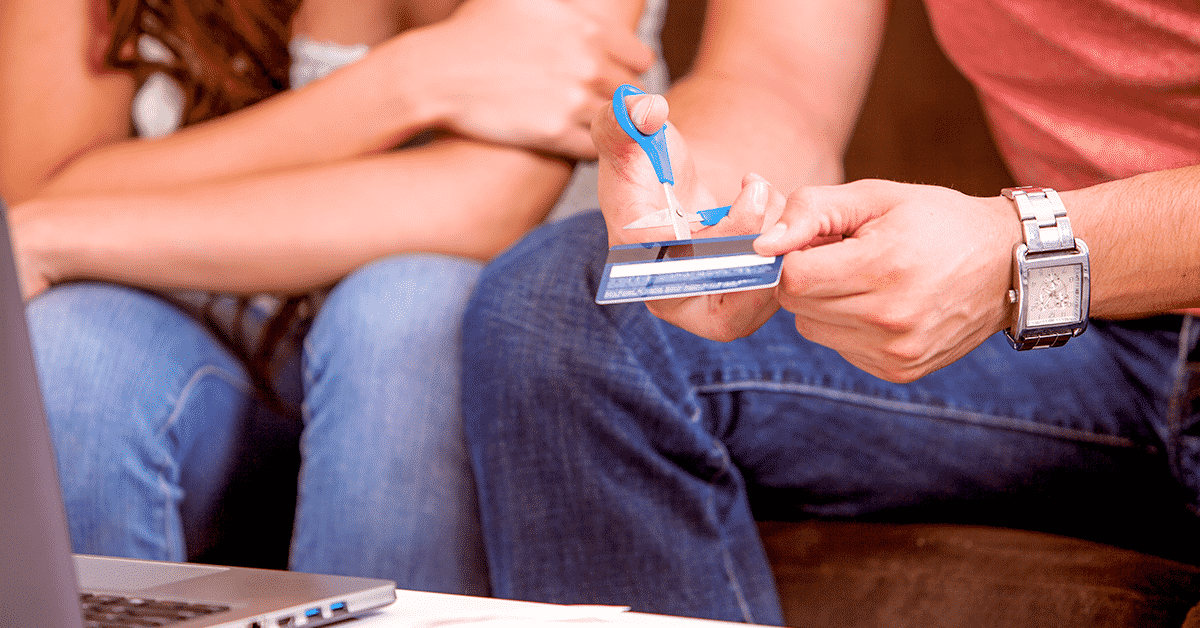
It’s easy to swipe a credit card, but paying it off is an entirely different story. Our society has normalized operating in debt to the point where it’s easy to forget the true cost of buying on credit. In fact, the 2019 Experian Consumer Credit Review revealed that the average American has four credit cards. Ouch!
There are some benefits to using credit cards, such as building your credit and earning rewards points. However, there are consequences of only making the minimum payment every month.
In fact, these consequences can outweigh the benefits, especially if you’re carrying a balance from month to month.
So this raises the question: what is the true cost of buying on credit?

How Do Credit Cards Work?
Before we do a deep dive into credit cards’ cost, it’s important to understand how they work.
In short, credit cards offer a convenient way to pay for large purchases through a line of credit. Rather than having to pay for the purchase in cash, your creditor (credit card company or bank) pays the expense for you. That money must be paid back to your creditor.
Similar to a traditional loan, credit cards charge interest every month. There is typically a 25 to 30 day “grace period.” If the balance of your purchases are not paid off in full by the due date, then interest charges will be applied to the remaining balance.
However, if you only pay the minimum balance due, then compound interest begins to work against you.
This is why many financial advisors will tell you: “Just because you can afford the minimum payment, it doesn’t mean that you can afford the purchase.”
How is Interest Calculated by Credit Card Companies?
If you pay your credit card bill in full every month, you won’t have to worry about it. But what happens when you carry (or “revolve”) a balance from month-to-month?
Once that due date passes, then interest is added to your account daily. This impacts previous purchases as well as any new purchases that are added to your account.
Every credit card works differently depending on the terms as well as your credit, but the computation of minimum payments and interest is generally the same.
To determine how your card’s interest is calculated, you’ll want to look at your annual percentage rate (APR). Your credit standing generally determines the APR that you’re approved for. Higher credit scores typically get lower APRs (interest rates), whereas lower credit scores get higher APRs. (If you want to see your credit score, check out Credit Karma.)
The typical range for APR is between 13% to 23%.
Once you know your APR, you’ll want to divide this number by 365 (representing 365 days in a year).
The Calculation
IMPORTANT:
Before you do this calculation, remember to turn the APR percentage into decimal format. In other words, move the decimal two places to the left. A 15% APR becomes 0.15, a 20% APR becomes 0.20, etc.This calculation will tell you the daily interest rate for your balance.
Let’s walk through an example together.
Step #1: Determine your APR.
Let’s say your APR is 17.28% (this is the average APR for all American credit cardholders).
Step #2: Convert your APR into decimal format.
Simply move the decimal two places to the left. Our 17.28% APR example would convert to 0.1728.
Step #3: Divide the APR (decimal format) by 365 (days of the year).
In this case, 0.1728 divided by 365 equals 0.0004734. The resulting number is your daily interest rate.
Step #4: Multiply the daily interest rate against your unpaid balance.
Let’s say that you have $1,000 in unpaid credit card bills. $1,000 x 0.0004734 = 0.47 cents. This is your interest charge for the first day (remember, interest is charged daily). So that means your total balance now stands at $1,000.47.
But…
Here’s where things get interesting: interest isn’t only charged to the original balance. It is now calculated based on the new balance, including the interest charges from previous days.
On Day #2, instead of simply adding another 0.47 cents to your balance, you repeat the same equation: balance x 0.0004734. But now your balance is slightly larger at $1,000.47.
It might not seem like a big deal at first, but soon the cost of interest will quickly begin building, especially if only the minimum payment is made month-after-month.
In order words, credit card interest works similar to compound interest, except unlike investments, the interest is now working against you.
If you only pay the minimum payment (let’s say $35 a month), the initial $1,000 purchase with an APR of 17.28% will take you three years and two months to pay off. The cost in interest will be $297.59, so your initial $1,000 purchase will actually cost you $1,297.59.
But… this is assuming that you don’t add any new purchases to the credit card!
Once you start accruing interest, new purchases will be included in the total balance, making the snowball of debt grow larger and larger.

How is the Minimum Payment Determined?
Again, every credit card company and bank is different, so you’ll want to look into your creditor's specific terms.
However, the general calculation is that the minimum payment is a percentage of your total statement balance. The range is typically between 1% and 3%.
So if you had a balance of $5,000 and your credit card company determines minimum payments by 2%, then your minimum payment for the month would be $100 (5,000 x 0.02).
Why You Should Avoid Only Paying the Minimum Due
If possible, pay off your credit card bill in full every month. However, if you must keep a revolving balance, then always pay more than the minimum payment that’s due. This will speed up the time it takes to pay off your balance fully. This also means that you will save an incredible amount from interest. If the balance gets too high, then the minimum payment might not be enough to pay off the month's interest charges.
Pro Tip: If you can make a payment before the due date, then do so! Why? Credit card interest is calculated daily. Every day that you wait to make a payment, then the larger your balance will grow. By making payments early, you can save on interest and pay off your debt faster!

How to Avoid the Painful Cost of Credit
So far in this article, we’ve only talked about the cost of interest.
Failing to pay your balance in full every month has other costs as well (damage to your credit score, mental stress, etc.).
If your credit card has yearly fees, then that also adds to the sting!
To avoid the cost of credit cards, try implementing these tips:
- Use a budget! Of course, pay with cash when possible! But if you want to take advantage of the perks that credit cards have to offer such as rewards points, then make sure you stick to a budget. Whether you use a written budget or an app, a budget will help you spend only what you can afford to pay.
- Keep a checking account cushion. We all fall on hard financial times. However, if you have a cushion or buffer in your checking account, then you can use that money to pay for expenses when things are tight. A cushion provides peace of mind and will help keep you from having to resort to credit cards to pay off those unexpected expenses.
- Put your credit card due date on your calendar. With so many things to keep track of, it can be easy to forget your credit card due date. Set a reminder on your phone or put this date in your calendar so that you never forget! Most credit card companies even have auto-payment options online to ensure you never miss a payment. Missed payments can be costly since they typically result in late fees!
Despite potential pitfalls, credit cards, when used responsibly, can have a number of benefits. For example, many hotels or car rental companies require credit cards for reservations. You can also use a credit card to build credit for larger purchases such as a house or a car.
Bottom Line
In short, aim to pay your credit card balance in full every month. If you’re keeping a well-detailed budget, then you should be spending within your means. And if for whatever reason you must have a revolving balance, keep this article in mind and remember to always pay more than the minimum balance.

